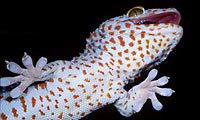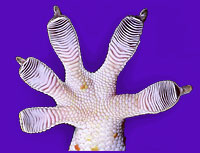BERKELEY
- Scientists have discovered the secret behind geckos'
ability to walk up walls and dangle from the ceiling, and
to prove it, have synthesized the very tips of the toe hairs
geckos rely on to stick.
 |
 |
| |
Tokay
gecko
© Photo: M. Moffett. |
| |
 |
| |
Tokay
gecko foot.
© Photo: M. Moffett. |
The minute
artificial hair tips, though rudimentary, work nearly as well
as the millions that line the geckos' own feet, showing that
it is possible to mimic nature and build nano-scale structures
that stick to many different surfaces and in environments
where glue-like adhesives fail.
"This
is the first step, this is the pathway to synthesizing the
first self-cleaning dry adhesive," said Robert J. Full,
professor of integrative biology at the University of California,
Berkeley. "It's going to take a lot of work to figure
out the best way to make a biologically inspired adhesive,
but this demonstrates that the path to manufacturing them
is there."
A self-cleaning
dry adhesive would have many uses, such as moving semiconductors
around in a vacuum chamber, and could stick to surfaces underwater
or in space.
Full, along
with colleagues at Lewis & Clark College in Portland Ore.,
UC Santa Barbara and Stanford University, report their findings
this week in the on-line edition of the Proceedings of the
National Academy of Sciences. The article will be published
on the PNAS Web site sometime during the week of Aug. 26.
"We
have solved the puzzle of how geckos use millions of tiny
foot-hairs to adhere to even molecularly smooth surfaces such
as polished glass," said Kellar Autumn, assistant professor
of biology at Lewis & Clark College and lead author of
the study. "Our new data prove once and for all how geckos
stick."
The proof
is in the pudding, though. Engineers at UC Berkeley created
synthetic hair tips that stick almost as well as the geckos'
own.
"We've
synthesized the smallest part of the entire foot, but now
we've got to make billions of them to get significant adhesive
force," said UC Berkeley's Ron Fearing, professor of
electrical engineering and computer science. "We don't
have a Post-it(r) yet."
Full and
Kellar reported two years ago the secret of getting gecko
toe hairs to stick without the use of suction, glue or static
electricity. They found that the angle the hair makes with
a surface is critical for controlling both sticking and release.
The hundreds or thousands of pads at the end of each hair
interact on a molecular level with the surface, generating
a combined attraction that keeps the gecko attached.
The tiny
pads, called spatulae, are like split ends, Full said, each
only 200 billionths of a meter wide - below the wavelength
of visible light. With up to 500,000 hairs per foot and hundreds
to a thousand split ends per hair, the sum total of intermolecular
forces, known to chemists as van der Waals forces, can amount
to 1,000 times the weight of a gecko.
"Intermolecular
forces come into play because the gecko foot hairs split and
allow a billion spatulae to increase surface density and come
into close contact with the surface. This creates a strong
adhesive force," Autumn said.
A single
seta can lift the weight of an ant, he said. A million setae,
which could easily fit onto the area of a dime, could lift
a 45-pound child. If a gecko used all of its setae at the
same time, it could support 280 pounds.
At the
time of its earlier paper, the team could not rule out several
physical effects that might also play a role in gecko adhesion.
For example, various animals, including frogs, insects and
some mammals, stick to surfaces by capillary adhesion, taking
advantage of the surface tension of a film of liquid. Many
of these animals have glands on their feet that secrete liquids
that help them stick. Geckos, though, have no such glands.
Nevertheless, the spatulae at the ends of the hairs on their
toes could be interacting with the thin water film - only
a molecule thick - that covers almost all surfaces.
To explore
this adhesive mechanism, the two biologists expanded their
team to include Stanford engineer Thomas Kenny, who precisely
measured the forces exerted by toe hairs; theoretical chemist
Jacob Israelachvili at UC Santa Barbara, who modeled toe hair
adhesion to see if prediction matched measurement; and UC
Berkeley's Fearing, who made synthetic spatulae.
They tested
the sticking power of gecko feet and toe hairs on different
types of polarizable surfaces, i.e., surfaces where the molecules
can shift around to attract or repel charged molecules, such
as water. Those that repel water are called hydrophobic surfaces,
while those that attract water are called hydrophilic. If
capillary adhesion were partly responsible, gecko feet would
stick better to water-loving or hydrophilic surfaces than
to hydrophobic surfaces.
Using nine
separate Tokay geckos - one of the largest geckos and a native
of Southeast Asia - the researchers found that the geckos'
toes, though hydrophobic, stuck equally well to the hydrophobic
semiconductor gallium arsenide on silicon and to the hydrophilic
semiconductor oxidized silicon. Kenny's lab showed also that
single setae stick equally well to hydrophobic and hydrophilic
MEMS (microelectromechanical system) sensors. The two experiments
confirmed that van der Waals forces are the most likely adhesive
mechanism.
Using a
well-known theory of adhesion, Israelachvili predicted the
size of spatulae required to make geckos stick, and obtained
an answer exactly in the range observed with gecko hairs.
The clincher
was creation of synthetic split ends that stick almost as
well as the real spatulae of Tokay geckos. With the help of
an atomic force microscope to punch wax molds of the right
size, Fearing cast little spatulae of two separate materials
- silicone rubber and polyester resin. He then used the microscope
to measure the adhesion force of these rubber feet.
"One
bump at the end sticks with 200 nanoNewtons of adhesive force,"
at least half of which is due to van der Waals forces, Fearing
said. "We confirmed that it's geometry, not surface chemistry,
that enables a gecko to support its entire body with a single
toe."
A nanoNewton
is the weight of a single blood cell, that is, the force exerted
on a blood cell by Earth's gravity. The force exerted by sunlight
on a satellite orbiting the Earth is on the order of 200 nanoNewtons.
Since fabricating
the initial nanobumps, Fearing and post-doctoral fellow Metin
Sitti have found a way to make arrays of 10,000 rubber bumps.
Though the centimeter-square arrays don't yet adhere to surfaces
better than rubber without bumps does, the team sees this
as proof of concept.
"We
can apply the underlying principles and create a similar adhesive
by breaking a surface into small bumps," Fearing said.
"These preliminary physical models provide proof that
humans can fabricate gecko glue."
Added Full,
"We've shown directly that something manufactured out
of different materials works by the same mechanism proposed
for gecko toe hairs. We think that the deformable nature of
these tiny tips, and perhaps the whole hair, allow you to
get very close to any kind of surface. That's the advantage."
Geckos
aren't the only creatures to evolve this sticking technique.
Anoles, skinks and insects use dry adhesion also, which means
that nature converged on the same solution several times,
Autumn said.
The key
design principle, discovered numerous times during evolution,
is that you can get very effective adhesion by simply taking
advantage of skin structure - keratin in the case of geckos,
anoles and skinks; chitin in the case of insects - and subdividing
it to create an array of microstructures that stick phenomenally,
he said. The animals didn't have to develop structures with
specialized surface chemistry, they simply took advantage
of the geometry.
Fearing
continues to explore the synthetic possibilities, including
what types of hair shafts make the best synthetic pads. Meanwhile,
Autumn and Full are exploring the natural variety of hairs
and pads to see what characteristics seem critical to a successful
dry adhesive.
The research
was funded by grants from the federal government's Defense
Advanced Research Projects Agency.
Full is
director of UC Berkeley's Poly-PEDAL lab, short for performance,
energetics, dynamics and animal locomotion. Fearing is a member
of the Center for Information Technology Research in the Interest
of Society (CITRIS), one of four California Institutes of
Science and Innovation.